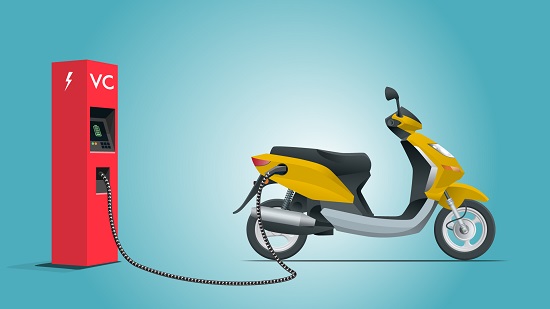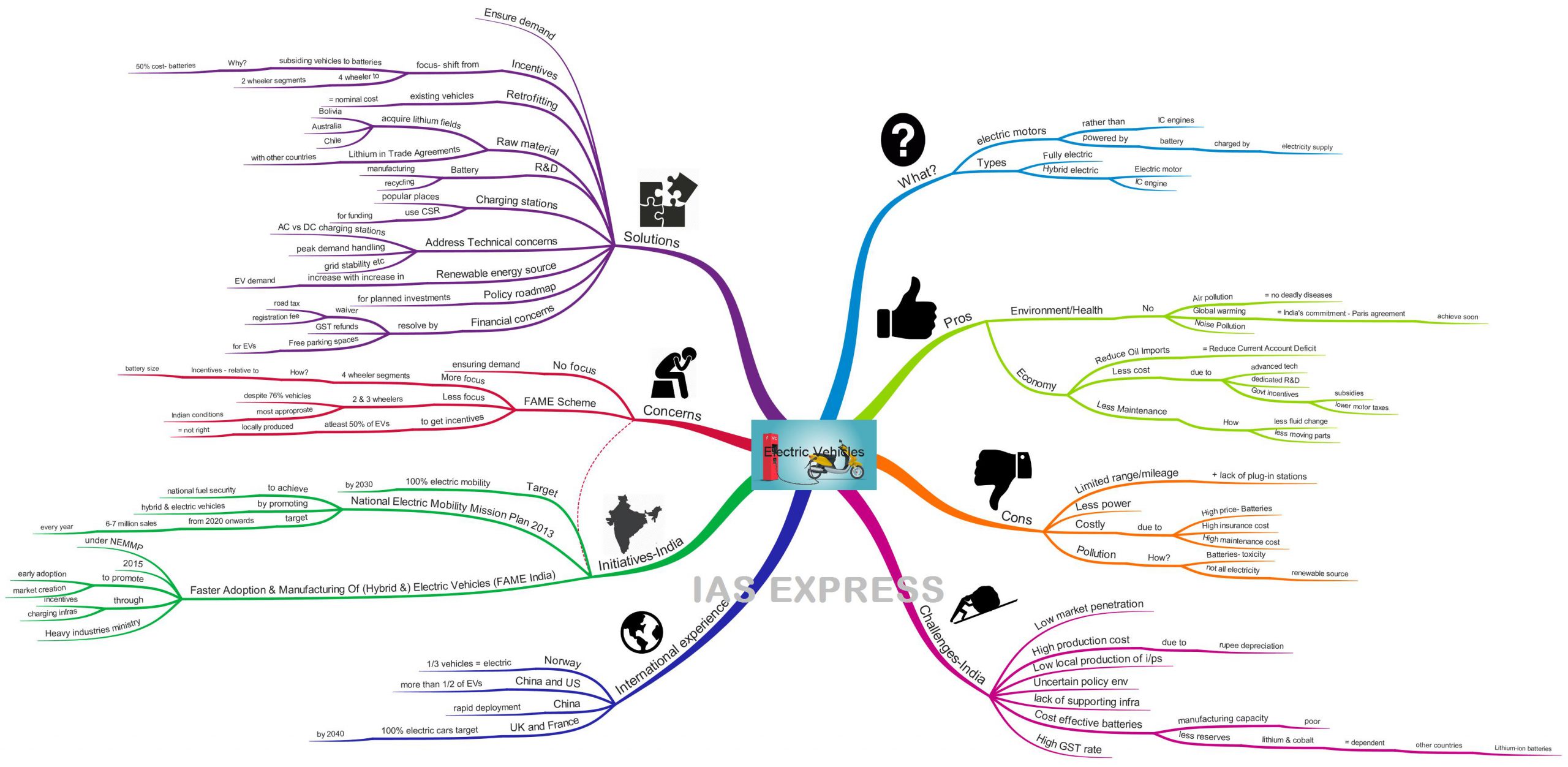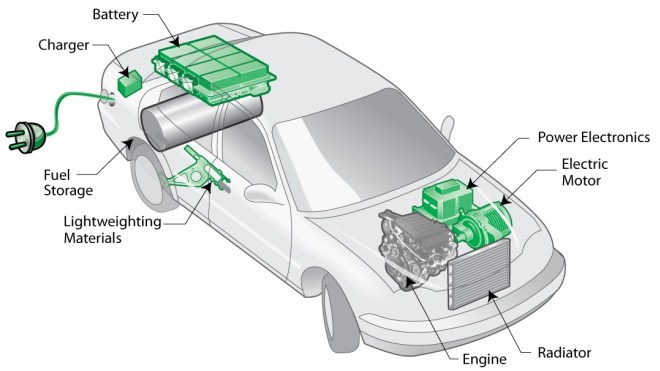Electric Vehicles – Is India Ready for it?

From Current Affairs Notes for UPSC » Editorials & In-depths » This topic
IAS EXPRESS Vs UPSC Prelims 2024: 80+ questions reflected
Updates *
The government has set the target of achieving 100% Electric vehicles by 2030. Manufacturing and putting the electric cars on road is the vision to make India pollution free along with saving billions of dollars in fuel cost and creating new job opportunities. However, there are also criticisms that India is not yet ready for electric vehicles which we will discuss in this article with a suitable way forward.
What are Electric Vehicles (EVs)?
- Electric vehicles, unlike conventional petrol and diesel vehicles, use one or more electric motors for propulsion rather than the internal combustion engine.
- Electric vehicles have a battery that is charged by means of electricity supply.
- The electric energy is then stored and used to run the electric motor.
- There are different types of electric vehicles. It includes fully electric vehicles and hybrid electric vehicles (Electric Motor + Combustion Engine).
What is the need for Electric Vehicles? (Advantages)
Environment/Health:
- Vehicles with Internal combustion (IC) engines cause half of the pollution in the cities as they emit harmful gases like Carbon Monoxide, Nitrogen Oxides, Sulphur Dioxide, Hydrocarbons, etc. = Air pollution & Global warming.
- The air pollution induces deadly diseases particularly for elderly people, pregnant women, and children.
- IC engines also cause noise pollution in cities.
- On the other hand, Electric Vehicles are 100% environment-friendly as they do not emit toxic gases or smoke in the environment which leads to global warming + they also operate quietly compared to conventional vehicles.
- It will help India in its commitment to the Paris Climate Agreement.
- Thus Electric vehicles provide the possibility of not only eliminating the pollution from cities but also improve the health and the environment as a whole.
Economy:
- Oil Imports: India is the 5th largest importer of oil, importing more than 2.2 million barrels a day to satisfy around 70% of demand in the country. Most of the consumption of oil is in the transport sector. Therefore electric vehicles can significantly reduce India’s oil imports = reduce Current Account Deficit.
- Cost-Effective: With the advent of advanced technology and dedicated R&D, the cost and maintenance of electric vehicles have gone down. The government is also incentivizing the use of electric vehicles by providing subsidies and lower motor taxes on EVs.
- Less Maintenance: Less Fluids (for oil and transmission) to change + Less Moving Parts in EVs = Less Maintenance.
What are the disadvantages of Electric Vehicles?
- Less Range: Electric engines provide only limited mileage. Complete battery recharge takes up to 8 hours and there is a lack of quick charge plug-in stations available across the country.
- Less Power: The top speed of electric cars is at 70 mph (even less for smaller electric vehicles) which makes them a poor bet with highway driving.
- Costly: Electric vehicles are costlier than gasoline-powered vehicles within the same range due to the hefty price of the lithium-ion batteries. Moreover, the insurance cost will be estimated to be higher for electric vehicles than conventional ones due to the danger of running out of power in a bad spot, its higher cost, and the dangers associated with electricity. Lastly, maintenance costs as a result of new technology and developing skills make electric cars even more costly.
- A small amount of Pollution: Even though electric vehicles are classified as green cars, the toxicity of batteries is high and not all electricity is derived from renewable energy sources.
What are the challenges for India in implementing Electric Mobility?
- Apart from the disadvantages as mentioned above, there are also key challenges unique to India with respect to electric vehicles.
- Market Penetration: Currently, the Indian electric vehicles’ market penetration is one of the lowest in the world.
- High production cost: The Indian EV industry has been hit hard because of the rapid depreciation of rupee = High production cost due to the high import cost of inputs.
- Local production of inputs: for EVs stands at just 35% of total inputs production.
- Policy: An uncertain policy environment and the lack of supporting infrastructure are major challenges of implementing EVs across India.
- Cost-effective batteries: India has only a limited ability to manufacture cost-effective batteries + it does not have any known reserves of lithium and cobalt = Dependent on imports of lithium-ion batteries from Japan and China.
- High GST rate for EVs = Less incentive for manufacturers/consumers to invest in or buy EVs.
What is the international experience?
- In Norway, one in three vehicles (33.1%) registered is plug-in electric.
- China and the US constitute more than half of electric cars in the world.
- China’s auto industry is rapidly turning all-electric.
- China aims at having 5 lakh public charging stations in place by 2020.
- UK and France are targeting 100% electric cars by 2040.
What are the initiatives taken in India?
Target: India has set a target of making a complete shift to electric mobility by 2030.
The National Electric Mobility Mission Plan (NEMMP) 2013
- It seeks to achieve national fuel security by promoting hybrid and electric vehicles in the country.
- It sets an ambitious target to achieve 6-7 million sales of hybrid and electric vehicles every year from 2020 onwards.
- The government has also announced the scheme named Faster Adoption and Manufacturing of (Hybrid&) Electric Vehicles (FAME India) under NEMMP with an initial allocation of Rs. 75 crore.
Faster Adoption and Manufacturing of (Hybrid &) Electric Vehicles (FAME India)
- The scheme was launched in 2015 to promote early adoption and market creation of both hybrid and electric vehicles in the country through upfront incentive on the purchase of Electric vehicles and also by way of establishing a necessary charging Infrastructure for electric vehicles.
- It is under the administrative control of the Ministry of Heavy Industries.
- Phase 2 of the scheme named FAME II – the expanded version of FAME with the allocation of Rs. 10,000 crore over 3 years was recently approved by the cabinet.
In addition to the FAME India scheme Phase II, different wings of Government are working to promote electric mobility in the country. Some of the major action in this regards are as given below: *
- GST on EVs is reduced to 5% from the current rate of 12%.
- The government has extended an additional income tax deduction of Rs 1.5 Lakh on interest paid on loans to the buyers of Electric Vehicle to buy EVs is provided.
- Ministry of Power has allowed the sale of electricity as ‘service’ for the charging of electric vehicles. This would serve as an incentive to attract investments into the charging infrastructure.
- MoRTH has issued a notification for the Green Number plate for the use of Electric Vehicles.
What are the concerns with the government’s efforts?
- Promoting EVs manufacturing without ensuring adequate demand for the vehicles produced.
- More incentives on 4-wheeler segments even though the electric 2-wheelers and 3-wheelers are most appropriate for Indian conditions. It is because 2-wheelers account for 76% of vehicles in the country and consume most of the fuel. However, under the FAME India scheme, the amount of incentive is relative to the size of the battery in the vehicle = more incentives for 4-wheeler segments.
- Moreover, for electric vehicle manufacturers to benefit from the FAME scheme, at least 50% of their EVs must be produced locally. However, it is not the right approach as has been experienced in the solar panels manufacturing.
What are the solutions?
- Ensure Demand: More focus should be given towards the creation of demand by making it easy and cheap for consumers to switch to electric vehicles.
- Incentives: The focus should also shift from subsidising vehicles to subsidizing batteries as batteries take up 50% of EV costs. And more incentives should be given for electric two-wheelers and three-wheeler segments than four-wheelers.
- Retrofitting: Retrofitting (addition of a new component/technology) existing small vehicles can be considered for a nominal cost for consumers. Example- the CNG fleet of Delhi’s auto-rickshaws can be turned into an all-electric/hybrid fleet at a very low cost to owners. But it will require some innovative finance on the part of the government.
- Raw material: Acquiring lithium fields in Bolivia, Australia and Chile could become as important as buying oil fields since India needs raw material to manufacture batteries for EVs. India could also diversify the supply risk by including lithium in existing Preferential Trade Agreements (PTAs) or creating new PTAs with other lithium producing countries.
- R&D: Creating a vibrant battery research and development ecosystem domestically to develop alternative technologies containing minerals with low supply risks + battery recycling techniques to recover the raw materials in the batteries.
- Charging points: A wide network of charging stations is required for attracting investments. Tech Parks, Public bus depots and Multiplexes are some of the potential places to install charging points. Corporates shall invest in charging infrastructure under Corporate Social Responsibility (CSR).
- Technical concerns: such as AC versus DC charging stations, handling of peak demand, grid stability, etc. should be addressed promptly.
- Renewable energy sources: should also increase with the increase in EV demand as high dependence on thermal sources would negate the EV’s environmental benefits.
- Policy roadmap: on EVs for planned investments in the sector.
- Financial concerns: can be addressed by providing a waiver of road tax and registration fees, GST refunds and free parking spaces for EVs.
Therefore, Electric vehicles have a long way to go before entering the mainstream as researchers develop new technologies, increase the availability of plug-in stations, and other disadvantages that make electric vehicles not yet ready for running on the roads of India. However, with innovative policy and implementation mechanism, the target of achieving 100% electric vehicles by 2030 could be realized much sooner.
Fuel Cell Electric Vehicles (FCEVs)*
If you like this post, please share your feedback in the comments section below so that we will upload more posts like this.





It’s very effective initiative at the same time, if this happened as soon as definitely all the environment will be changed perfectly after that we can get hundered percent pure oxygen and by this innovative in future never seen pollution and regarding this need to show awareness posters and related program activitys..